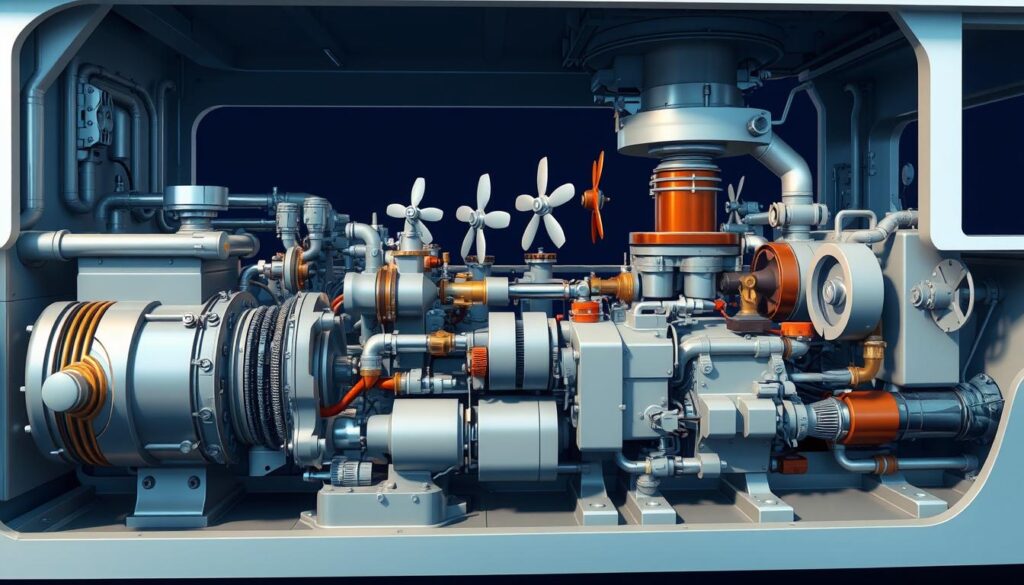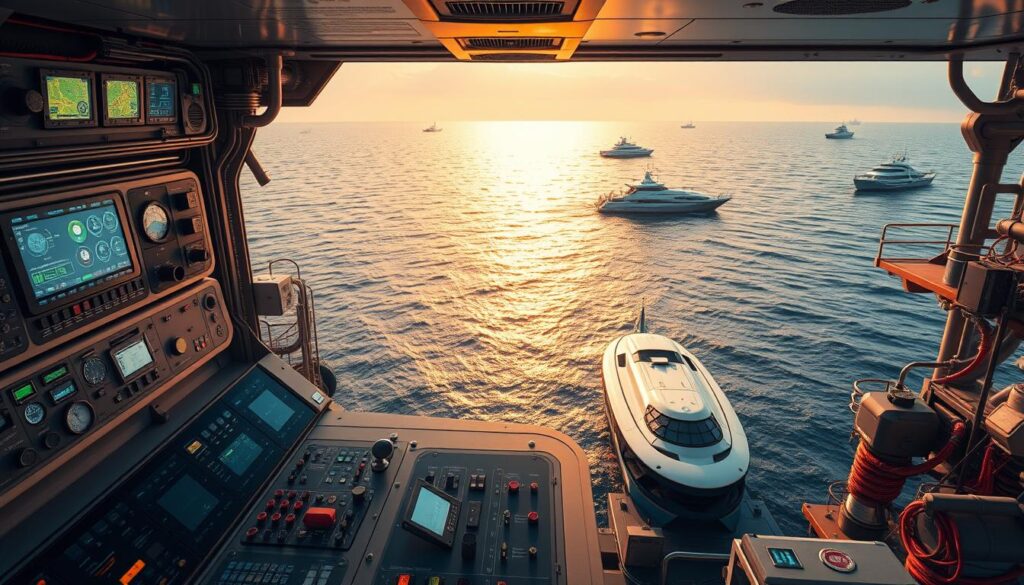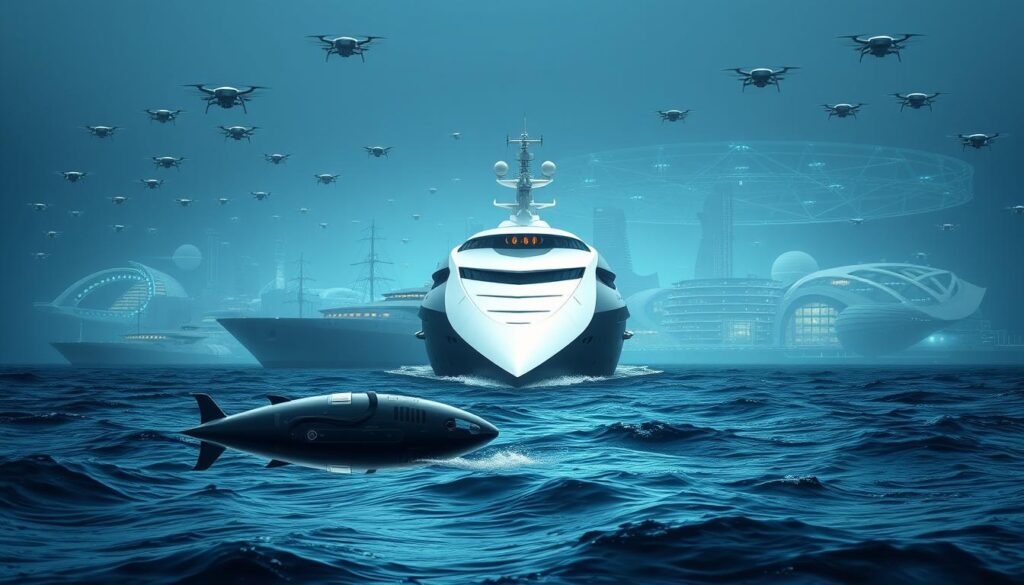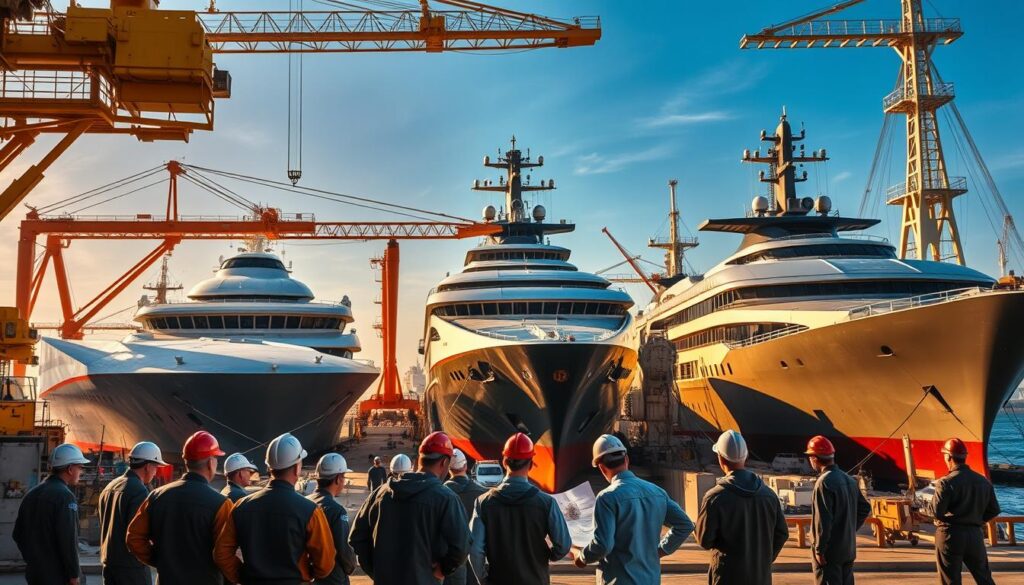The maritime industry has long been a vital component of global commerce and exploration. Marine engineering plays a crucial role in this sector, encompassing a broad range of disciplines that facilitate the exploration and utilization of ocean resources.
As the world’s dependence on the ocean continues to grow for resources, transportation, and recreation, the importance of ocean engineering and related technologies becomes increasingly evident. The field is evolving rapidly, driven by innovations in marine technology.
Key Takeaways
- Understanding the role of marine engineering in the maritime industry.
- The significance of ocean engineering in resource utilization.
- Advancements in marine technology driving industry growth.
- Career opportunities in the field of marine engineering.
- Future directions for marine engineering and its applications.
The Evolution of Maritime Technology
The maritime industry has undergone significant transformations over the centuries, driven by advances in technology and changing global demands. From ancient seafaring practices to modern sophisticated vessel designs, maritime technology has evolved substantially.
Historical Milestones in Seafaring
The history of maritime technology is marked by several key milestones. The transition from sail to steam power in the 19th century revolutionized the industry, enabling faster and more reliable transportation. The development of containerization in the 20th century further transformed global trade, streamlining cargo handling and reducing transit times.
Other significant advancements include the introduction of radar and electronic navigation aids, which have greatly enhanced safety at sea. The use of satellite communications has also improved connectivity and operational efficiency for vessels worldwide.
From Wooden Ships to Modern Vessels
The shipbuilding industry has seen a dramatic shift from traditional wooden ships to modern vessels constructed from steel and advanced composites. Modern naval architecture incorporates sophisticated design techniques, including computer-aided design (CAD) and computational fluid dynamics (CFD), to optimize vessel performance and efficiency.
The table below highlights some key differences between traditional and modern shipbuilding practices:
| Characteristics | Traditional Shipbuilding | Modern Shipbuilding |
|---|---|---|
| Materials | Wood, sailcloth | Steel, advanced composites |
| Design Techniques | Manual drafting | CAD, CFD |
| Propulsion | Sail, early steam engines | Diesel, gas turbines, electric propulsion |
The evolution of maritime technology continues, driven by the need for greater efficiency, safety, and environmental sustainability. As the industry moves forward, we can expect to see further innovations in shipbuilding and naval architecture, shaping the future of global trade and maritime operations.
What Is Marine Engineering?
At its core, marine engineering is about harnessing engineering expertise to meet the challenges of the marine environment, from offshore oil rigs to commercial shipping vessels. This multidisciplinary field combines principles from various branches of engineering to design, construct, and operate marine vessels and structures.

Core Principles and Disciplines
Marine engineering encompasses a wide range of disciplines, including mechanical engineering, electrical engineering, and materials science. The field involves the design and operation of marine propulsion systems, such as diesel engines, gas turbines, and nuclear reactors, as well as the development of marine systems like steering and stabilization systems.
Some of the key activities in marine engineering include:
- Designing and installing propulsion systems and other equipment on ships and offshore platforms
- Developing and implementing safety systems to prevent accidents and minimize environmental impact
- Conducting inspections and maintenance to ensure the integrity and efficiency of marine vessels and structures
The Intersection with Naval Architecture
Marine engineering is closely related to naval architecture, which focuses on the design and construction of ships and other floating structures. While naval architects are concerned with the overall design, stability, and performance of vessels, marine engineers focus on the engineering aspects, such as propulsion, steering, and safety systems.
Together, marine engineers and naval architects work to create efficient, safe, and environmentally friendly marine vessels and structures. Their collaborative efforts are crucial in advancing marine structures and technologies that support global trade and economic development.
Ship Design and Construction
The evolution of ship design and construction has been driven by the need for more efficient, sustainable, and safe maritime vessels. Advancements in materials science and computer-aided design have transformed the shipbuilding industry, enabling the creation of more sophisticated vessels.
Modern Shipbuilding Techniques
Modern shipbuilding techniques have revolutionized the industry, improving both efficiency and quality. Two significant advancements are steel fabrication and assembly, and modular construction methods.
Steel Fabrication and Assembly
Steel fabrication and assembly are critical components of modern shipbuilding. Advanced welding techniques and precision cutting have improved the strength and durability of vessels. According to industry experts, “The use of advanced steel fabrication techniques has significantly reduced construction time and improved vessel quality.”
Modular Construction Methods
Modular construction involves building sections of the vessel in separate modules, which are then assembled on the shipyard. This method allows for parallel processing, reducing overall construction time and increasing efficiency.
Materials Science in Vessel Construction
The development of new materials and technologies has been instrumental in advancing vessel construction. High-strength steels, composites, and advanced alloys are being used to create stronger, lighter, and more durable vessels. As noted by a leading naval architect, “The application of advanced materials has enabled the construction of vessels that are not only more efficient but also more environmentally friendly.”
“The future of shipbuilding lies in the adoption of innovative materials and construction techniques.”
Computer-Aided Design in Shipbuilding
Computer-aided design (CAD) has revolutionized the shipbuilding industry, allowing for more precise and efficient design and construction processes. CAD software enables designers to create detailed models, simulate performance, and optimize vessel design. The use of CAD has significantly reduced design time and improved vessel performance.
In conclusion, the integration of modern shipbuilding techniques, advanced materials, and computer-aided design has transformed the ship design and construction industry. As the maritime industry continues to evolve, these advancements will play a crucial role in shaping the future of shipbuilding.
Marine Propulsion Systems
At the heart of every marine vessel lies a propulsion system, a complex assembly of technologies that drive the vessel through the water. These systems are crucial for the operation of ships, influencing their speed, maneuverability, and overall efficiency.
Conventional Marine Diesel Engines
Conventional marine diesel engines have been the mainstay of the maritime industry for decades, providing a reliable and relatively efficient means of propulsion. These engines are known for their durability and ability to operate for extended periods without major maintenance. However, they also have drawbacks, including emissions of greenhouse gases and other pollutants.

Alternative Propulsion Technologies
In response to environmental concerns and the need for greater efficiency, the maritime industry is turning to alternative propulsion technologies. These include LNG (Liquefied Natural Gas) and hybrid systems, as well as electric and nuclear propulsion.
LNG and Hybrid Systems
LNG and hybrid systems offer a more environmentally friendly alternative to traditional diesel engines. LNG, for example, significantly reduces sulfur oxide emissions and can lower greenhouse gas emissions. Hybrid systems, which combine different power sources, can optimize fuel efficiency and reduce emissions further.
Electric and Nuclear Propulsion
Electric propulsion systems, which use electric motors powered by generators or batteries, offer high efficiency and low emissions. Nuclear propulsion, while less common, provides a high energy density source that can power large vessels over long distances without refueling.
Efficiency and Environmental Considerations
The choice of marine propulsion system has significant implications for both the efficiency of the vessel and its environmental impact. As the industry moves towards more sustainable practices, the development and adoption of cleaner, more efficient propulsion technologies will be crucial.
| Propulsion System | Efficiency | Environmental Impact |
|---|---|---|
| Conventional Diesel | Moderate | High emissions |
| LNG | High | Lower emissions |
| Hybrid | High | Lower emissions |
| Electric | Very High | Low emissions |
| Nuclear | Very High | Low emissions during operation |
Offshore Engineering Challenges
The challenges associated with offshore engineering are multifaceted, requiring innovative solutions to withstand harsh marine environments. Offshore engineering involves the design, construction, and operation of structures and platforms in the ocean, often in deep water.
Deep-Sea Structures and Platforms
Deep-sea structures and platforms are critical components of offshore engineering, enabling the extraction of oil and gas, as well as the installation of renewable energy systems. These structures must be designed to withstand extreme environmental conditions, including high winds, strong currents, and corrosive seawater.
Oil and Gas Platforms
Oil and gas platforms are complex structures that require careful planning and execution. They must be designed to support the weight of drilling equipment, pipelines, and other infrastructure, while also withstanding harsh marine conditions. The design of these platforms involves a range of considerations, including stability, durability, and safety.
Subsea Infrastructure
Subsea infrastructure, including pipelines and cables, plays a vital role in offshore engineering. These systems must be designed to operate reliably in harsh environments, with minimal maintenance and inspection requirements. The use of advanced materials and technologies is crucial in ensuring the integrity of subsea infrastructure.
Environmental Factors and Design Considerations
Environmental factors have a significant impact on the design of offshore structures and platforms. Engineers must consider a range of factors, including wave loading, currents, and seabed conditions, when designing these systems. The use of advanced modeling and simulation tools is essential in predicting the behavior of offshore structures under various environmental conditions.
By understanding the challenges associated with offshore engineering and addressing them through innovative design and construction techniques, the industry can continue to develop safe, efficient, and environmentally friendly solutions for the extraction of energy resources and the installation of renewable energy systems.
Marine Systems Integration
The integration of various marine systems is key to enhancing the safety and productivity of maritime operations. Modern vessels and offshore structures rely on complex systems working in harmony to operate efficiently.
Electrical and Power Systems
Electrical and power systems are the backbone of modern marine vessels. These systems provide the necessary power for propulsion, lighting, and onboard equipment. Advances in power management technologies have significantly improved the efficiency and reliability of marine electrical systems.
Navigation and Communication Technologies
Effective navigation and communication are critical for safe maritime operations. Modern navigation systems utilize GPS and electronic chart display systems to provide accurate positioning and route planning. Communication technologies, including satellite communications, enable vessels to stay in contact with shore-based operations and other ships.
Safety Systems and Redundancies
Safety systems are essential for protecting both the crew and the environment. These systems include emergency beacons, fire suppression systems, and backup power generators. Implementing redundancies in critical systems ensures that vessels can continue to operate safely even in the event of component failure.

| System | Function | Importance |
|---|---|---|
| Electrical and Power | Provides power for vessel operations | High |
| Navigation and Communication | Ensures safe navigation and communication | High |
| Safety Systems | Protects crew and environment | Critical |
Underwater Vehicles and Robotics
Underwater vehicles and robotics are transforming our understanding of marine ecosystems and enhancing offshore operations. These technologies have become indispensable in the field of marine engineering, facilitating complex tasks such as inspection, maintenance, and repair of underwater infrastructure.
Remotely Operated Vehicles (ROVs)
Remotely Operated Vehicles (ROVs) are robotic submarines controlled from the surface, used for a variety of underwater tasks. They are equipped with manipulator arms, cameras, and sensors, enabling them to perform delicate operations and gather critical data.
Autonomous Underwater Vehicles (AUVs)
Autonomous Underwater Vehicles (AUVs) are unmanned submarines that operate independently, following pre-programmed routes. They are used for mapping the seafloor, monitoring water quality, and detecting underwater hazards.
Applications in Exploration and Maintenance
Underwater vehicles and robotics have numerous applications in exploration and maintenance. They are used to inspect offshore oil rigs, maintain underwater pipelines, and explore shipwrecks. The data collected by these vehicles is invaluable for research and development in marine science.
| Vehicle Type | Primary Use | Key Features |
|---|---|---|
| ROVs | Inspection, Maintenance, Repair | Manipulator arms, Cameras, Sensors |
| AUVs | Seafloor Mapping, Water Quality Monitoring | Pre-programmed routes, Autonomous operation |
The integration of underwater vehicles and robotics into marine engineering has marked a significant shift towards more efficient and safe operations. As technology continues to evolve, we can expect these vehicles to play an even more critical role in ocean exploration and resource management.
Marine Renewable Energy Solutions
As the world shifts towards renewable energy, marine renewable energy solutions are emerging as a vital component in the global effort to combat climate change. The ocean’s vast potential is being tapped into through various technologies.
Wave and Tidal Energy Systems
Wave and tidal energy systems represent a promising frontier in marine renewable energy. These systems harness the kinetic energy of ocean waves and tides, converting it into electricity. The potential for wave and tidal energy is substantial, particularly in coastal regions with high tidal ranges or significant wave activity.

Offshore Wind Technology
Offshore wind technology has seen rapid advancements in recent years, making it a leading source of marine renewable energy. Offshore wind farms are capable of generating substantial amounts of electricity.
Fixed Foundation Structures
Fixed foundation structures are a common approach for offshore wind turbines, particularly in shallower waters. These structures provide a stable base for the turbines, ensuring efficient energy production.
Floating Wind Platforms
Floating wind platforms are an innovative solution for deeper waters where fixed foundations are not feasible. These platforms allow for the installation of wind turbines in a wider range of marine environments, expanding the potential for offshore wind energy.
Maritime Regulations and Compliance
The maritime industry is governed by a complex set of regulations aimed at ensuring safety and environmental protection. These regulations are critical for the safe operation of vessels and offshore structures, as well as for minimizing the environmental impact of maritime activities.
International Maritime Organization Standards
The International Maritime Organization (IMO) is a specialized agency of the United Nations responsible for setting global standards for maritime safety and environmental protection. The IMO has implemented various conventions and regulations, such as the International Convention for the Safety of Life at Sea (SOLAS) and the International Convention for the Prevention of Pollution from Ships (MARPOL), to ensure the safe and sustainable operation of maritime vessels.
Some of the key IMO standards include:
- Requirements for ship design, construction, and equipment
- Regulations for the prevention of pollution from ships
- Standards for maritime safety and security
Environmental Protection Measures
In addition to safety regulations, the maritime industry is also subject to various environmental protection measures. These measures are designed to minimize the impact of maritime activities on the environment.
Emission Control Areas
One of the key environmental protection measures is the establishment of Emission Control Areas (ECAs). ECAs are designated areas where stricter controls are imposed on emissions from ships, such as sulfur oxides (SOx) and nitrogen oxides (NOx). The IMO has designated several ECAs around the world, including the North Sea and the Baltic Sea.
Ballast Water Management
Another important environmental protection measure is Ballast Water Management (BWM). BWM regulations aim to prevent the transfer of invasive aquatic species through ballast water discharge. The IMO has implemented the Ballast Water Management Convention to regulate the management of ballast water on ships.
By complying with these regulations, the maritime industry can minimize its environmental footprint and ensure a safer and more sustainable operation.
The Future of Marine Engineering
Emerging technologies are set to redefine the landscape of marine engineering, offering unprecedented opportunities for growth and development. As the industry continues to evolve, it’s crucial to understand the trends and innovations that will shape its future.
Emerging Technologies and Innovations
The integration of cutting-edge technologies is transforming marine engineering. From artificial intelligence to advanced materials, these innovations are enhancing efficiency, safety, and sustainability.
Artificial Intelligence and Automation
Artificial intelligence (AI) and automation are revolutionizing various aspects of marine engineering, including ship design, operation, and maintenance. AI algorithms can optimize routes, predict maintenance needs, and improve overall vessel performance.
Advanced Materials and Manufacturing
The development of advanced materials and manufacturing techniques is enabling the creation of stronger, lighter, and more durable marine structures. These advancements are crucial for improving the efficiency and reducing the environmental impact of marine vessels and infrastructure.
Sustainable Practices in Maritime Industries
Sustainability is becoming increasingly important in the maritime industry, with a focus on reducing emissions, minimizing waste, and promoting eco-friendly practices. Sustainable practices are not only beneficial for the environment but also offer economic advantages through improved efficiency and reduced operational costs.
The maritime industry is adopting various sustainable practices, including the use of renewable energy sources, green technologies, and eco-friendly materials. These practices are crucial for minimizing the industry’s environmental footprint and ensuring a sustainable future.

Marine Engineering Career Opportunities
Marine engineering is a diverse field that encompasses a wide range of career paths, from design and construction to operation and maintenance. As the maritime industry continues to evolve, the demand for skilled marine engineers is on the rise.
Education and Training Pathways
A career in marine engineering typically begins with a strong educational foundation. Many aspiring marine engineers pursue degrees in marine engineering or related fields such as mechanical engineering or naval architecture. Specialized programs that offer courses in marine systems, thermodynamics, and fluid mechanics are particularly valuable.
Hands-on training is also crucial in this field. Internships and apprenticeships with shipping companies, shipyards, or offshore engineering firms provide practical experience that is essential for success in marine engineering.
Job Roles and Specializations
Marine engineers can specialize in various areas, including:
- Ship design and construction
- Marine propulsion systems
- Offshore engineering
- Underwater vehicles and robotics
Within these specializations, job roles can range from design engineer to operations manager, each requiring a unique set of skills and knowledge.
Industry Demand and Salary Expectations
The demand for marine engineers is influenced by the growth of the global maritime industry, including shipping, offshore oil and gas, and renewable energy sectors. According to industry reports, the employment of marine engineers is projected to grow, driven by the need for new vessels and the retrofitting of existing ones with more efficient technologies.
| Job Role | Average Salary (USD) | Growth Prospects |
|---|---|---|
| Marine Engineer | 80,000 – 120,000 | High |
| Design Engineer | 70,000 – 110,000 | Moderate |
| Operations Manager | 90,000 – 140,000 | High |
As the maritime industry continues to evolve, the career opportunities for marine engineers are expected to expand, offering a promising outlook for those entering this field.

Case Studies: Breakthrough Marine Engineering Projects
Recent advancements in marine engineering have led to the development of groundbreaking projects that are changing the face of the industry. These innovations are not only enhancing the efficiency and safety of maritime operations but are also paving the way for a more sustainable future.

Innovative Vessel Designs
The design of vessels is a critical aspect of marine engineering, with recent years seeing significant innovations in this area. Two notable examples are autonomous ships and energy-efficient cargo vessels.
Autonomous Ships
Autonomous ships represent a significant leap forward in maritime technology. These vessels use advanced navigation systems and sensors to operate without human intervention, reducing the risk of accidents caused by human error. Companies like Rolls-Royce and Maersk are at the forefront of developing autonomous shipping solutions.
Energy-Efficient Cargo Vessels
Energy-efficient cargo vessels are another area where marine engineering is making a significant impact. By incorporating designs that reduce drag and improve propulsion efficiency, these vessels are able to reduce their fuel consumption and lower emissions. This not only benefits the environment but also reduces operational costs for shipping companies.
Groundbreaking Offshore Structures
Offshore structures, such as oil rigs and wind farms, are complex engineering feats that require innovative solutions to withstand harsh marine environments. Recent advancements in materials science and construction techniques have enabled the development of more robust and sustainable offshore structures.
Advancements in Materials Science have played a crucial role in enhancing the durability and efficiency of offshore structures. New materials that offer greater resistance to corrosion and can withstand extreme conditions are being used in the construction of these structures.
Revolutionary Marine Systems
Marine systems, including propulsion, navigation, and safety systems, are being revolutionized by advancements in technology. For instance, the integration of AI and IoT in marine systems is enhancing their efficiency and reliability.
The use of advanced propulsion systems, such as hybrid and fully electric propulsion, is becoming more prevalent. These systems offer significant reductions in emissions and operational costs, making them an attractive option for shipping companies looking to modernize their fleets.
Conclusion: The Boundless Horizons of Marine Engineering
Marine engineering is a dynamic field that continues to evolve, driven by technological advancements and the need for sustainable practices. As we have explored throughout this article, the discipline encompasses a broad range of applications, from ship design and construction to offshore engineering and marine renewable energy.
The future directions of marine engineering are promising, with emerging technologies and innovations poised to transform the maritime industry. As the world grapples with environmental challenges, marine engineering will play a critical role in developing solutions that balance economic needs with ecological sustainability.
By embracing cutting-edge technologies and fostering collaboration among industry stakeholders, marine engineers can unlock new opportunities and drive progress in the field. As we look to the future, it is clear that marine engineering will remain a vital component of the global economy, shaping the way we interact with and utilize the world’s oceans.
